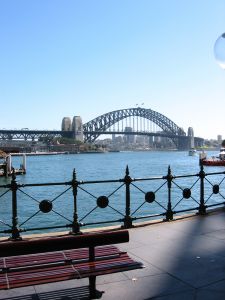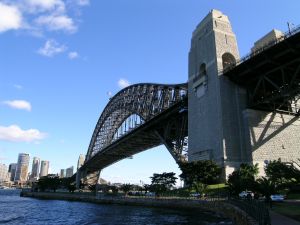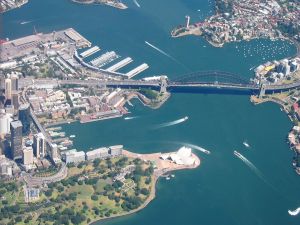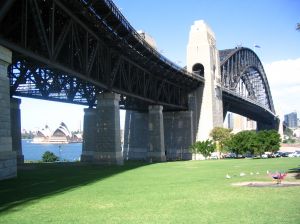Sydney Harbour Bridge - An Aussie Icon

My father was born in Sydney and lived there until he joined the Navy at 18. One of my father’s happiest childhood memories was in 1932, as a 5 year old boy, he and other classmates (in their first year of school) were herded into public transport and bussed to the just completed Sydney Harbour Bridge for the opening ceremony, and was then amongst the first to people walk across the opened bridge.
He remembers the fanfare and speeches, the excitement of the crowd and then the very long walk across the bridge. As a young small child the bridge seemed the biggest and strongest structure he’d ever seen or even been near, and he used to say that once the bridge was built, Sydney came of age.
The bridge was designed by a Queenslander, Dr J.J.C. Bradfield an eminent architect and designer who not only designed the Sydney Harbour Bridge, but the Storey Bridge in Brisbane, and underground railways stations including the Circular Quay railway station.
The Sydney Harbour Bridge is the fifth longest spanning-arch bridge in the world, and is also the tallest steel arch bridge on the planet.
The convict settlement of Sydney, established in 1788, had grown into a large sprawling city by the 1900’s and the need for a harbour crossing was becoming very pressing. As early as 1815, the settlement architect Francis Greenway had proposed a bridge to be built, but because of economic conditions and ongoing administrative priorities it didn’t actually become a reality until 1912 when J.J.C.Bradfield was appointed Chief Engineer of Sydney Harbour Bridge and Metropolitan Railway Construction.
The onset of the First World War thwarted plans for a bridge and it wasn’t until 1922 when Bradfield travelled abroad in search of a suitable design. The final design of an arch bridge was agreed upon in 1922 and construction began in July 1923. The building of the bridge was to coincide with the construction of a large railway network, both under and above ground.
Train, automobile and cycle and foot traffic needed to be catered for, as well as the capacity for large ships to pass unheeded under the bridge on a daily basis. The bridge was going to need to be very big, very strong and built to last. In January 1932 the first test train was driven across the bridge and passed the load test with flying colours.
The bridge was official opened at both the northern and southern ends, at the same time on the 19th March 1932. Jack Lang Premier of NSW on the southern side and the Mayor of Sydney Alderman Primrose on the north side.
Sydney was awash with celebrations for the opening of the bridge. Suburbs held street parties, Eisteddfods were held, special postage stamps were issued and on the day of the opening, Sydney’s citizens were invited to walk across the bridge. It is estimated that approximately 700,000 people took part in the opening festivities, which was a great achievement considering the population of Sydney at the time was a little over a million people.
My father recalls being shepherded across the bridge by his school teacher, and students holding hands so’s not to get lost. This was the only occasion for another 50 years (for its 50th Anniversary), that the bridge would be closed and pedestrians allowed to walk its roads.
Given that the bridge was built and opened during the world’s worst depression, it is considered most of the major structural achievements of the 20th Century, and the bridge has become an Australian icon, one that is recognised the world over.
He remembers the fanfare and speeches, the excitement of the crowd and then the very long walk across the bridge. As a young small child the bridge seemed the biggest and strongest structure he’d ever seen or even been near, and he used to say that once the bridge was built, Sydney came of age.
The bridge was designed by a Queenslander, Dr J.J.C. Bradfield an eminent architect and designer who not only designed the Sydney Harbour Bridge, but the Storey Bridge in Brisbane, and underground railways stations including the Circular Quay railway station.
The Sydney Harbour Bridge is the fifth longest spanning-arch bridge in the world, and is also the tallest steel arch bridge on the planet.
The convict settlement of Sydney, established in 1788, had grown into a large sprawling city by the 1900’s and the need for a harbour crossing was becoming very pressing. As early as 1815, the settlement architect Francis Greenway had proposed a bridge to be built, but because of economic conditions and ongoing administrative priorities it didn’t actually become a reality until 1912 when J.J.C.Bradfield was appointed Chief Engineer of Sydney Harbour Bridge and Metropolitan Railway Construction.
The onset of the First World War thwarted plans for a bridge and it wasn’t until 1922 when Bradfield travelled abroad in search of a suitable design. The final design of an arch bridge was agreed upon in 1922 and construction began in July 1923. The building of the bridge was to coincide with the construction of a large railway network, both under and above ground.
Train, automobile and cycle and foot traffic needed to be catered for, as well as the capacity for large ships to pass unheeded under the bridge on a daily basis. The bridge was going to need to be very big, very strong and built to last. In January 1932 the first test train was driven across the bridge and passed the load test with flying colours.
The bridge was official opened at both the northern and southern ends, at the same time on the 19th March 1932. Jack Lang Premier of NSW on the southern side and the Mayor of Sydney Alderman Primrose on the north side.
Sydney was awash with celebrations for the opening of the bridge. Suburbs held street parties, Eisteddfods were held, special postage stamps were issued and on the day of the opening, Sydney’s citizens were invited to walk across the bridge. It is estimated that approximately 700,000 people took part in the opening festivities, which was a great achievement considering the population of Sydney at the time was a little over a million people.
My father recalls being shepherded across the bridge by his school teacher, and students holding hands so’s not to get lost. This was the only occasion for another 50 years (for its 50th Anniversary), that the bridge would be closed and pedestrians allowed to walk its roads.
Given that the bridge was built and opened during the world’s worst depression, it is considered most of the major structural achievements of the 20th Century, and the bridge has become an Australian icon, one that is recognised the world over.

Related Articles
Editor's Picks Articles
Top Ten Articles
Previous Features
Site Map
Content copyright © 2023 by Judie Bellingham. All rights reserved.
This content was written by Judie Bellingham. If you wish to use this content in any manner, you need written permission. Contact Judie Bellingham for details.







